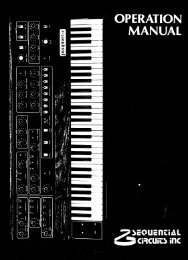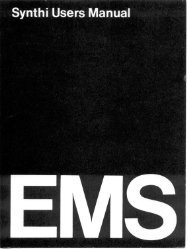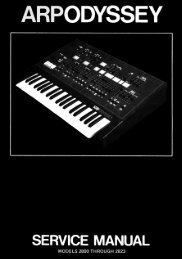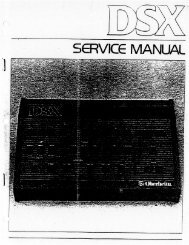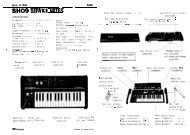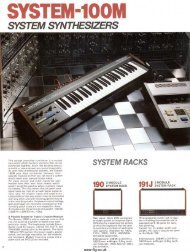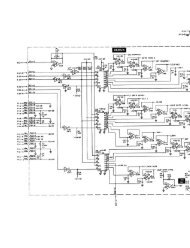ARP2600 - Fundamentals of Music Technology - Cyborgstudio.com
ARP2600 - Fundamentals of Music Technology - Cyborgstudio.com
ARP2600 - Fundamentals of Music Technology - Cyborgstudio.com
Create successful ePaper yourself
Turn your PDF publications into a flip-book with our unique Google optimized e-Paper software.
014 - SECTION TWO: VCO-1When plugging into the FM three jacks on the right <strong>of</strong>VCO-1, the user can control the amount <strong>of</strong> controlvoltage that will actually get to the oscillator. Whenthe slider or fader (the two terms are used interchangeablyin this book) above a jack is all the way down, nosignal will be passed to the oscillator from that jack.When the slider is all the way up, all <strong>of</strong> the in<strong>com</strong>ingcontrol signal will be allowed to modulate the oscillator.When a fader is all the way down (or all the wayto the left) it is said to be closed. Conversely, whenthe slider is set all the way up (or all the way to theright) it is said to be open.The left most FM CONTROL jack is normalled to thekeyboard’s control voltage. One can tell that the keyboardcontrol voltage is normalled to this input sinceFigure 2-4: VCO-1’s FM jacksthe words “KBD CV” appear in the white box under the input. Since it is keyboard CV that is normalledhere, it is usually desirable to have all <strong>of</strong> the keyboard control voltage modulating the frequency<strong>of</strong> the oscillator. Thus, there is no fader above this input, and all <strong>of</strong> the in<strong>com</strong>ing control signal willalways modulate the oscillator. If a fader was present above this jack, then all <strong>of</strong> the voltage would notget to the VCO, and the keyboard would not produce chromatic half steps from one note to the next.There is some use for this technique, and it will be explored later in this section. Frequency modulationis the final way that Figure 2-5 below sums up all <strong>of</strong> the ways VCO-1’s frequency can be changed.THE KEYBOARD AND REDUNDANT PATCHESVCO-1VCO-1’s frequencyis determined by:• Coarse Tune• Fine Tune• Control Voltageconnected to FMinputs. (This includes the keyboardCV normal)Figure 2-5The control voltage produced by the keyboard is normalled to each oscillator.When the keyboard is played, it sends out a control voltage for each key, andthe oscillator will change its frequency depending upon how much voltage itreceives from the keyboard. This is a great example <strong>of</strong> voltage control discussedin Section 1. This is how the synthesizer is able to play different pitcheswhen different notes are played on the keyboard. The keyboard’s normal to theoscillator can be broken by inserting a dummy plug into the Keyboard CV jack.Sometimes people have trouble remembering that the keyboard’s control voltageis normalled to the oscillators. It is possible to patch the keyboard’s controlvoltage output on the front panel to the keyboard control voltage FM input onVCO-1, but this is not necessary, since the keyboard control voltage is alreadynormalled to each oscillator. Creating this patch would just be redoing what thenormal has already ac<strong>com</strong>plished. If a patch is created which duplicates theeffect <strong>of</strong> a normal, it is called a redundant patch. Patching the keyboard CVoutput to the keyboard CV jack on VCO-1 is a perfect example <strong>of</strong> a redundantpatch. This redundant patch is illustrated in Figure 2-6 on Page 15. (The heavyred line represents a patch cord.)




